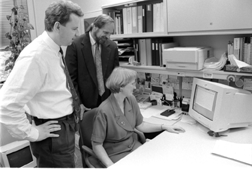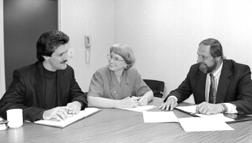The University Record, October 15, 1996
M-Pathways project will help answer
‘Where is that centrifuge?’
 M-Pathways project team members John Jeske (left), Michael Easter and Marilyn Pendorf check out the latest on a computer screen.
M-Pathways project team members John Jeske (left), Michael Easter and Marilyn Pendorf check out the latest on a computer screen.
By Gretchen Weir
M-Pathways Project
What is the likelihood of the University misplacing a set of floor scrubbers, several central processing units, or a slew of centrifuges? “Not likely,” says Mike Easter of the M-Pathways Physical Resources Management and Planning Team. “Someone probably knows their whereabouts. Someone may even know their value. The trick is knowing who.”
Guesswork is not good enough, argues Easter, a facility administrator in housing before joining the M-Pathways Project. “Think of what’s involved in managing the 190,000 assets owned by the University. We need a system for tracking repair schedules, planning for replacements and pinpointing the location of equipment. It must include current value as equipment depreciates. And it should work as well for desktop computers, white boards and fax machines as it does for million-dollar microscopes.”
Effective asset management is essential for accurately measuring the University’s financial position, points out Paul Spradlin, associate vice president for Business Operations. “The M-Pathways System will make it easier for us to know exactly what equipment we have and what its value is.” Easy to access, on-line asset information, rather than annual inventory figures, would also help risk managers know whether the University is adequately insured.
The PeopleSoft software that Easter and his team are introducing this week will make the University’s asset management easier for individual units and for the University as a whole. A portion of the M-Pathways system, this asset management package is being unveiled at University Hospitals in a pilot program started earlier this month. Campuswide implementation will begin in mid-1997.
“Since 1991, we have used a centralized system to track assets,” explains Glenn Cerny, the M-Pathways team leader for Physical Resources Management and Planning. “It wasn’t easy to get information back to the units from that centralized system, so many units had to keep track of things on their own. This new system is a simple way to continue to track the large ticket items, while also giving individual departments a flexible tool for their individual needs.”
 At right, David Rose joins Pendorf and Easter at a planning session.
At right, David Rose joins Pendorf and Easter at a planning session.
To learn how individual units now track their smaller assets, the M-Pathways Asset Management team has hosted focus groups over the last three months. Representatives from such diverse areas as Plant Maintenance, Plant Extension, University Libraries, the College of Engineering, the Office of Risk Management, LS&A, and the School of Dentistry have described how they currently manage equipment and what additional information they would like to capture. These discussions have revealed the duplicate effort that has been expended as units create separate solutions from scratch, often using spreadsheets or paper check lists.
The focus groups also highlighted the need for units to share information. When the researcher leaves or a grant runs out, it isn’t always clear who owns what. In addition, there is no easy way to advertise the availability of the remaining equipment. While equipment may have outlived its usefulness for the original researcher, it may be of use elsewhere. Focus group members were pleased to see the PeopleSoft system will capture detailed information on equipment and its availability, so that they can search for available equipment before buying new. They also liked the myriad of other details, such as repair history, maintenance schedules, warranty information, and custodianship (which identifies who is responsible for an asset when it is taken off campus), that a unit can record.
Why does the hospital get to use this system first? Eager for an easier way to manage their valuable medical equipment, the hospital agreed to participate in a pilot program. “Our old system needed replacing,” says David Rose, Manager of Capital Assets at the Hospital. “We saw this as an opportunity.” Although the system has been extensively tested, “experience in a real working environment is necessary before we know if we have it the way we want it,” says Easter. “We are grateful to have the Hospital as our partner in this first phase.” The M-Pathways Project’s implementation strategy is to try out system modules on a small scale before introducing them across campus.
|
Feeling uncertain about the M-Pathways Project? When: 10:30 a.m.-noon or 1:30-3 p.m. Where: Kuenzel Room, Michigan Union What: Discussion of project history, scope and necessity Speakers: Laura Patterson, project manager, and Bill Wrobleski, technical infrastructure team. |

